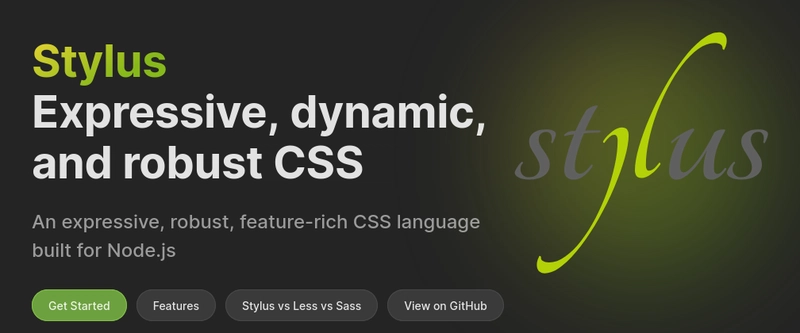Imagine you're painting a wall. With traditional CSS, it's like using a fine brush: it works, but it's a lot of effort. Preprocessors are like paint sprayers — faster, less work, and a smoother finish.
Have you ever found yourself copying and pasting the same styles in multiple places in your CSS? Or wished CSS had variables and functions like a real programming language?
That’s where CSS preprocessors like SASS, SCSS, and Stylus come in. They're like superpowers that extend CSS with features beyond what the browser understands natively.
What Are Preprocessors?
Preprocessors are tools that transform a language similar to CSS (but with extra features) into regular CSS that the browser understands.
They allow:
- Variables
- Functions
- Loops
- Conditionals
- Imports between files
- Code reuse with mixins
Imagine being able to write CSS as if you're actually programming, with logic, reuse, and structure.
SASS and SCSS: Two Styles, One Soul
SASS stands for Syntactically Awesome Style Sheets. It comes in two formats:
-
.sass(indentation-based, no braces or semicolons) -
.scss(similar to traditional CSS, uses braces and semicolons)
Comparison Example
Plain CSS
/* Plain CSS */
h1, h2 {
font-family: Arial, sans-serif;
}
h1 {
color: #3498db;
}
h2, p {
color: #ccc;
}
SCSS
// SCSS (uses {}, ;, and looks like CSS):
The result:
// SASS (no {}, no ;, uses identation):
$cor-principal: #3498db
$fonte-padrao: Arial, sans-serif
h1, h2
color: $cor-principal
font-family: $fonte-padrao
Both SCSS and SASS produce the same CSS in the end. The only difference is the syntax you prefer.
Reusability with Mixins
Imagine a standard button used throughout your site:
// SCSS
@mixin standard-button {
padding: 10px 20px;
border-radius: 8px;
background: #2ecc71;
color: white;
}
.login-button {
@include standard-button;
box-shadow: 2px 2px 5px rgba(0,0,0,0.2);
}
This saves you from repeating the same properties over and over. And the best part? If you want to change the background of all buttons, just update the @mixin.
Logic with Style
Preprocessors let you use:
Conditionals (if/else)
$dark-theme: true;
body {
background: if($dark-theme, #000, #fff);
}
Loops
@for $i from 1 through 3 {
.m-$i {
margin: $i * 10px;
}
}
Generates:
.m-1 { margin: 10px; }
.m-2 { margin: 20px; }
.m-3 { margin: 30px; }
Other Useful Features
-
@import→ imports another SCSS file -
@extend→ inherits styles from another selector
// SCSS
%base-button {
font-weight: bold;
}
.button {
@extend %base-button;
padding: 8px;
}
Stylus: CSS Freestyle
Stylus is the most flexible of the three. You can use braces, semicolons... or not. Even the variable symbol is optional!
Example:
// Stylus
primary = lightblue
.button
font-size 16px
color primary
You can also create functions:
add(a, b)
a + b
.container
margin add(10px, 20px)
This generates:
.container {
margin: 30px;
}
Why Use Preprocessors?
- Better code organization
- Less repetition
- Easier to maintain large projects
- Helps enforce patterns and design systems
If you're learning CSS, mastering preprocessors will give you a big edge in the market.
Which One to Use?
| Tool | Syntax | Learning Curve | Popularity |
|---|---|---|---|
| SCSS | Familiar (CSS) | Low | High |
| SASS | Indented | Medium | Medium |
| Stylus | Flexible | Medium | Medium |
If you want an easy start: SCSS
If you like minimalism: SASS
If you want full freedom: Stylus
When Should You Use Them?
If you:
- Work on large projects
- Hate repeating code
- Want to keep your CSS clean and organized
- Care about productivity
Quick Challenge
Try converting this CSS into SCSS using variables and mixins and comments your answer:
.card {
background: white;
color: black;
padding: 20px;
border-radius: 8px;
}
Conclusion
CSS is good. But with preprocessors, you become a true style alchemist. More efficiency, better organization, and more freedom to create amazing interfaces.
Want to level up like a design ninja? Try SCSS or Stylus in your next project and feel the difference.
If you found this helpful, save this post and share it with a friend who’s still stuck with plain CSS.
Let’s master frontend with elegance and practicality. See you in the next post!






Top comments (3)
learned a lot!
Nice, bro. I glad hear this.
Could you tell me your available time for chat? 😁